The Historical Building and Room Acoustics of the Stockholm Public Library (1925–28, 1931–32)
Abstract
1. Introduction
2. Architecture and Background of the Stockholm Public Library
3. Materials and Methods
4. Results
4.1. Room Acoustics: Background Noise and Reverberation
4.2. Building Acoustics: Airborne and Impact Sound Insulation
5. Discussion
5.1. Reverberation in the Library’s Central Rotunda
5.2. Impact Sound Insulation of the Western Reading Room 3
6. Conclusions
Funding
Data Availability Statement
Acknowledgments
Conflicts of Interest
References
- Jones, P.B.; Kang, J. Acoustic Form in the Modern Movement. Arch. Res. Q. 2003, 7, 75–85. [Google Scholar] [CrossRef][Green Version]
- Fischer, S.V. A Visual Imprint of Moving Air: Methods, Models, and Media in Architectural Sound Photography, ca. 1930. J. Soc. Arch. Hist. 2017, 76, 326–348. [Google Scholar] [CrossRef][Green Version]
- Darò, C. Lines for Listening: On Gustave Lyon’s Geometrical Approach to Acoustics. J. Archit. 2018, 23, 881–902. [Google Scholar] [CrossRef]
- Clarke, J. Echo’s Chambers: Architecture and the Idea of Acoustic Space; University of Pittsburgh Press: Pittsburgh, PA, USA, 2021; ISBN 9780822946571. [Google Scholar]
- Addis, B. A Brief History of Design Methods for Building Acoustics. In Proceedings of the Third International Congress on Construction History, Cottbus, Germany, 20–24 May 2009; pp. 1–10. [Google Scholar]
- Touloumi, O. Sound in Silence: Design and Listening Cultures in the Woodberry Poetry Room. J. Archit. 2018, 23, 1003–1029. [Google Scholar] [CrossRef]
- Fischer, S.V. Das Akustische Argument; gta Verlag: Zurich, Switzerland, 2019. [Google Scholar]
- Broyles, J.M.; Self, I.P.; Brown, N. Revisiting the Viipuri Library: Assessing Performance and Design Trade-Offs in Custom Ceiling Geometry. In Proceedings of the IASS 2022 Symposium affiliated with APCS 2022 conference Innovation·Sustainability·Legacy, Beijing, China, 19–23 September 2022; pp. 1–12. [Google Scholar]
- Fischer, S.V.; Touloumi, O. Sound Modernities: Histories of Media and Modern Architecture. J. Arch. 2018, 23, 873–880. [Google Scholar] [CrossRef]
- Fischer, S.V. Tapping Machines: Listening to Difference, 1928–1956. gta Pap. 2017, 124–134. [Google Scholar] [CrossRef]
- Sabine, W.C. Collected Papers on Acoustics; Harvard University Press: Cambridge, MA, USA, 1922. [Google Scholar]
- Aletta, F.; Kang, J. (Eds.) Historical Acoustics; MDPI: Basel, Switzerland, 2020; ISBN 9783039285266. [Google Scholar]
- Queirós, D.; Rodrigues, R.C.; Pereira, N. Historical Building Acoustical Retrofit: An Experimental Examination of Traditional Wooden Floors. Build. Acoust. 2016, 23, 181–191. [Google Scholar] [CrossRef]
- Grochowska, E.; Kaliszuk, J.; Gil, J. The Parameters of the Acoustic Insulation Capacity of a Reinforced Wooden Ceiling. MATEC Web Conf. 2018, 174, 01020. [Google Scholar] [CrossRef][Green Version]
- Rodrigues, R.C.; Queirós, D.; Caetano, E. Flanking Transmission of Airborne Sound Involving Wooden and Stone Elements in Historical Buildings. Build. Acoust. 2018, 25, 363–376. [Google Scholar] [CrossRef]
- Aletta, F.; Kang, J. Historical Acoustics: Relationships between People and Sound over Time. Acoustics 2020, 2, 128–130. [Google Scholar] [CrossRef]
- Farina, A. Acoustic Quality of Theatres: Correlations between Experimental Measures and Subjective Evaluations. Appl. Acoust. 2001, 62, 889–916. [Google Scholar] [CrossRef]
- Chourmouziadou, K.; Kang, J. Acoustic Evolution of Ancient Greek and Roman Theatres. In Proceedings of the 23rd International Congress on Sound and Vibration, Athens, Greece, 10–14 July 2016; Volume 69, pp. 514–529. [Google Scholar]
- Barkas, N. The Contribution of the Stage Design to the Acoustics of Ancient Greek Theatres. Acoustics 2019, 1, 337–353. [Google Scholar] [CrossRef]
- D’Orazio, D.; Nannini, S. Towards Italian Opera Houses: A Review of Acoustic Design in Pre-Sabine Scholars. Acoustics 2019, 1, 252–280. [Google Scholar] [CrossRef]
- Beranek, L.L. Concert Hall Acoustics: Recent Findings. J. Acoust. Soc. Am. 2016, 139, 1548–1556. [Google Scholar] [CrossRef] [PubMed]
- Đorđević, Z.; Novković, D.; Andrić, U. Archaeoacoustic Examination of Lazarica Church. Acoustics 2019, 1, 423–438. [Google Scholar] [CrossRef]
- Alonso, A.; Suárez, R.; Sendra, J.J. The Acoustics of the Choir in Spanish Cathedrals. Acoustics 2018, 1, 35–46. [Google Scholar] [CrossRef]
- Katz, B.F.G.; Weber, A. An Acoustic Survey of the Cathédrale Notre-Dame de Paris before and after the Fire of 2019. Acoustics 2020, 2, 791–802. [Google Scholar] [CrossRef]
- Álvarez-Morales, L.; Lopez, M.; Álvarez-Corbacho, Á. The Acoustic Environment of York Minster’s Chapter House. Acoustics 2020, 2, 13–36. [Google Scholar] [CrossRef]
- Gül, Z.S. Acoustical Impact of Architectonics and Material Features in the Lifespan of Two Monumental Sacred Structures. Acoustics 2019, 1, 493–516. [Google Scholar] [CrossRef]
- Warusfel, O.; Emerit, S. Assessing the Acoustics of an Ancient Egyptian Temple. In Proceedings of the 2021 Immersive and 3D Audio: From Architecture to Automotive (I3DA), Bologna, Italy, 8–10 September 2021; pp. 1–6. [Google Scholar] [CrossRef]
- Markham, B. A Survey of the Acoustical Quality of Seventeen Libraries at Princeton University. J. Acoust. Soc. Am. 2003, 114, 2316. [Google Scholar] [CrossRef]
- Kang, J.; Du, Z. Sound Field and Acoustic Comfort in Library Reading Rooms. In Proceedings of the Tenth International Congress on Sound and Vibration, Stockholm, Sweden, 7–10 July 2003; pp. 1–8. [Google Scholar]
- Markham, B. Acoustic Comfort in Libraries. In Proceedings of the 33rd International Congress and Exposition on Noise Control Engineering, Prague, Czech Republic, 22–25 August 2004; pp. 1–14. [Google Scholar]
- Rosenbaum, J.E.; Krumhansl, C.L.; Hove, M.J. Fine-Tuning the Acoustics of Libraries at Colleges and Universities. J. Acoust. Soc. Am. 2006, 119, 3401. [Google Scholar] [CrossRef]
- Markham, B. The Right Kind of Quiet. Libr. J. 2010. Available online: https://web.archive.org/web/20201019223148/https://www.libraryjournal.com/?detailStory=the-right-kind-of-quiet (accessed on 19 October 2019).
- Rajagopalan, P.; Nguyen, H.T.H.; Carre, A. Acoustic Performance of Contemporary Public Libraries: An Evaluation of Public Libraries in Melbourne, Australia. Archit. Sci. Rev. 2017, 60, 104–115. [Google Scholar] [CrossRef]
- Zamin, N.; Ajis, A.M.; Ismail, A. Space Planning Determinants to Achieve Acoustical Comfort in Libraries: A Literature Review. In Proceedings of the Virtual Go-Green: Conference and Publication (V-Go Green 2020), Bota, Malaysia, 29–30 September 2020; pp. 43–48. [Google Scholar]
- Brothánek, M.; Jandák, V.; Jiříček, O. Expectations of the Acoustic Environment in the National Library of Technology—Case Study. Appl. Acoust. 2020, 170, 107507. [Google Scholar] [CrossRef]
- Mattern, S. Resonant Texts: Sounds of the American Public Library. Senses Soc. 2015, 2, 277–302. [Google Scholar] [CrossRef]
- Xiao, J.; Aletta, F. A Soundscape Approach to Exploring Design Strategies for Acoustic Comfort in Modern Public Libraries. Noise Mapp. 2016, 3, 264–273. [Google Scholar] [CrossRef]
- Yorukoglu, P.N.D.; Kang, J. Analysing Sound Environment and Architectural Characteristics of Libraries through Indoor Soundscape Framework. Arch. Acoust. 2016, 41, 203–212. [Google Scholar] [CrossRef]
- Woo, J.; Rajagopalan, P. Soundscapes in Public Libraries. In Back to the Future: The Next 50 Years (51st International Conference of the Architectural Science Association (ANZAScA)); Schnabel, M.A., Ed.; Architectural Science Association (ANZAScA): Wellington, New Zealand, 2017; pp. 685–694. [Google Scholar]
- Siebein, G.W. The Soundscape of Twenty-First-Century Libraries. Acoust. Today 2020, 16, 57–66. [Google Scholar] [CrossRef]
- Stockholm, L. Byggnadsminnen. Available online: https://www.lansstyrelsen.se/stockholm/samhalle/kulturmiljo/byggnadsminnen.html (accessed on 5 August 2024).
- Wrede, S. The Architecture of Erik Gunnar Asplund; MIT Press: Cambridge, MA, USA, 1980. [Google Scholar]
- Jones, P.B. Gunnar Asplund; Phaidon: London, UK, 2006; ISBN 0 7148 3976 0. [Google Scholar]
- Hawkes, D. The Environmental Imagination, Technics and Poetics of the Architectural Environment; Taylor and Francis: Abingdon, UK, 2008; ISBN 9781138628984. [Google Scholar]
- Steane, M.A. Reading Light at Seinajoki, Finland, and Viano Do Castelo, Portugal. In The Architecture of Light Recent Approaches to Designing with Natural Light; Routledge: London, UK, 2011; pp. 77–104. ISBN 9780415394796. [Google Scholar]
- Bergström, A. Det Moderna Monumentet: Stadsbiblioteket och den Historiska Värderingen [The Modern Monument. Stockholm Public Library and Its Historical Reception]. Nord. J. Settl. Hist. Built Herit. 2011, 62, 8–24. Available online: https://uu.diva-portal.org/smash/get/diva2:1545713/FULLTEXT01.pdf (accessed on 1 May 2024).
- Ortelli, L. La Pertinence de Gunnar Asplund; Métis Presses: Les Acacias, Switzerland, 2019; ISBN 978-2-940563-48-7. [Google Scholar]
- Schwartz, M. Light from All Around: Asplund’s Stockholm Library. In Proceedings of the 6th VELUX Daylight Symposium, Copenhagen, Denmark, 4 September 2015; pp. 1–4. [Google Scholar]
- Andersen, M.A. Stockholm Public Library: Erik Gunnar Asplund. In The Companions to the History of Architecture, Volume IV, Twentieth-Century Architecture; Leatherbarrow, D., Eisenschmidt, A., Eds.; Wiley: Hoboken, NJ, USA, 2017; Volume 4, pp. 1–14. [Google Scholar]
- Fleming, P.H.; Bergström, A. Archival Plans, Alterations, and 3D Laser Scanning of Erik Gunnar Asplund’s Stockholm Public Library. Archit. Res. Q. 2023, 27, 209–222. [Google Scholar] [CrossRef]
- Fleming, P.; Mill, P.; Torres, M.R.; Bergström, A. Recovering the Historical Construction and Materials of Erik Gunnar Asplund’s Stockholm Public Library. Docomomo J. 2024, 71, 13–23. [Google Scholar] [CrossRef]
- Asplund, E.G. Några uppgifter om biblioteksbygget [Some Notes on the Library Building]. Byggmästaren 1928, 7, 100–104. [Google Scholar]
- Arbetsbeskrivning för Stockholms Stadsbiblioteks Nybyggnad [Specifications for the New Building of the Stockholm City Library]; Kurt Lindberg, Boktryckeriaktiebolag: Stockholm, Sweden, 1924.
- Thompson, E. The Soundscape of Modernity: Architectural Acoustics and the Culture of Listening in America, 1900–1933; MIT Press: Cambridge, MA, USA, 2002; ISBN 9780262201384. [Google Scholar]
- Raytchine, N.; Boumier, A.; Tchayeff, S. Construction de Planchers Insonores [Construction of Sound-Proof Floors]. French Patent No. 491.517, 3 July 1925. [Google Scholar]
- Kreuger, H. Research in Acoustics Problems in Buildings; Ingeniörs Vetenskaps Akademienshandlingar; A.-B. Gunnar Tisells Tekniska Förlag: Stockholm, Sweden, 1924; Volume 38. [Google Scholar]
- Kreuger, H. Undersökningar Rörande Byggnadskonstruktioners Ljudisoleringsförmaga [Studies on the Sound Insulation Performance of Building Structures]; Ingeniörs Vetenskaps Akademienshandlingar; A.-B. Gunnar Tisells Tekniska Förlag: Stockholm, Sweden, 1927; Volume 74. [Google Scholar]
- Swallow, J.C.; Wesolowsky, M.J.; Busch, T.A. This Ain’t Your Daddy’s Library—The Challenges of Modern Library Acoustics. Can. Acoust. Acoust. Can. 2015, 43, 32–33. [Google Scholar]
- Crawford, A. (Ed.) The Meaning of the Library: A Cultural History; Princeton University Press: Princeton, NJ, USA, 2015. [Google Scholar]
- ISO 3382-2:2008; Acoustics—Measurement of Room Acoustic Parameters—Part 2: Reverberation Time in Ordinary Rooms. International Organization for Standardization: Geneva, Switzerland, 2008.
- ISO 16283-1:2014; Acoustics—Field Measurement of Sound Insulation in Buildings and of Building Elements—Part 1: Airborne Sound Insulation. International Organization for Standardization: Geneva, Switzerland, 2014.
- ISO 16283-2:2020; Acoustics—Field Measurement of Sound Insulation in Buildings and of Building Elements—Part 2: Impact Sound Insulation. International Organization for Standardization: Geneva, Switzerland, 2020.
- Sakagami, K.; Kiyama, M.; Morimoto, M.; Takahashi, D. Sound Absorption of a Cavity-Backed Membrane: A Step towards Design Method for Membrane-Type Absorbers. Appl. Acoust. 1996, 49, 237–247. [Google Scholar] [CrossRef]
- Fratoni, G.; Garai, M.; D’Orazio, D. Assessment of Modal Density and Free Path Distribution in Central-Planned Halls. J. Acoust. Soc. Am. 2023, 154, 3604–3614. [Google Scholar] [CrossRef] [PubMed]
- Gino, I.; Amelia, T. The Acoustics of the Vanvitelliana Hunting Lodge. In Proceedings of the 17th Conference on Applied Mathematics, Bratislava, Slovakia, 6–8 February 2018; pp. 468–478. Available online: http://evlm.stuba.sk/APLIMAT2018/proceedings/Papers/0468_Iannace_Trematerra.pdf (accessed on 5 August 2024).
- Bevilacqua, A.; Sukaj, S.; Ciaburro, G.; Iannace, G.; Lombardi, I.; Trematerra, A. How a Quartet of Theatres Plays under an Acoustic Perspective: A Comparison between Horseshoe Shaped Plans in Campania. Build. Acoust. 2022, 29, 317–329. [Google Scholar] [CrossRef]
- Leccese, F.; Rocca, M.; Salvadori, G. Fast Estimation of Speech Transmission Index Using the Reverberation Time: Comparison between Predictive Equations for Educational Rooms of Different Sizes. Appl. Acoust. 2018, 140, 143–149. [Google Scholar] [CrossRef]
- Daniels, R. Building Bulletin 93—Acoustic Design of Schools: Performance Standards; UK Department of Education: London, UK, 2015.
- ISO 717-1:2020; Acoustics—Rating of Sound Insulation in Buildings and of Building Elements—Part 1: Airborne Sound Insulation. International Organization for Standardization: Geneva, Switzerland, 2020.
- ISO/TS 19488:2021; Acoustics—Acoustic Classification of Dwellings. International Organization for Standardization: Geneva, Switzerland, 2021.
- ISO 717-2:2020; Acoustics—Rating of Sound Insulation in Buildings and of Building Elements—Part 2: Impact Sound Insulation. International Organization for Standardization: Geneva, Switzerland, 2020.
- Sundin, G. Spelbomskan Alt B: Teknisk Beskrivning Akustik, Systemhandling [Spelbomskan Alt B: Technical Description Acoustics, System Document]; AKUSTIKON ett Team i Norconsult AB: Gothenburg, Sweden, 2018; pp. 1–44. [Google Scholar]
- Schiavon, D.I.; Canale, S.; Griginis, A.P. Design Requirements for a Contemporary Library: How to Achieve Acoustic Well-Being Conditions. In Proceedings of the 10th Convention of the European Acoustics Association Forum Acusticum 2023, Torino, Italy, 11–15 September 2023; pp. 3001–3003. [Google Scholar] [CrossRef]




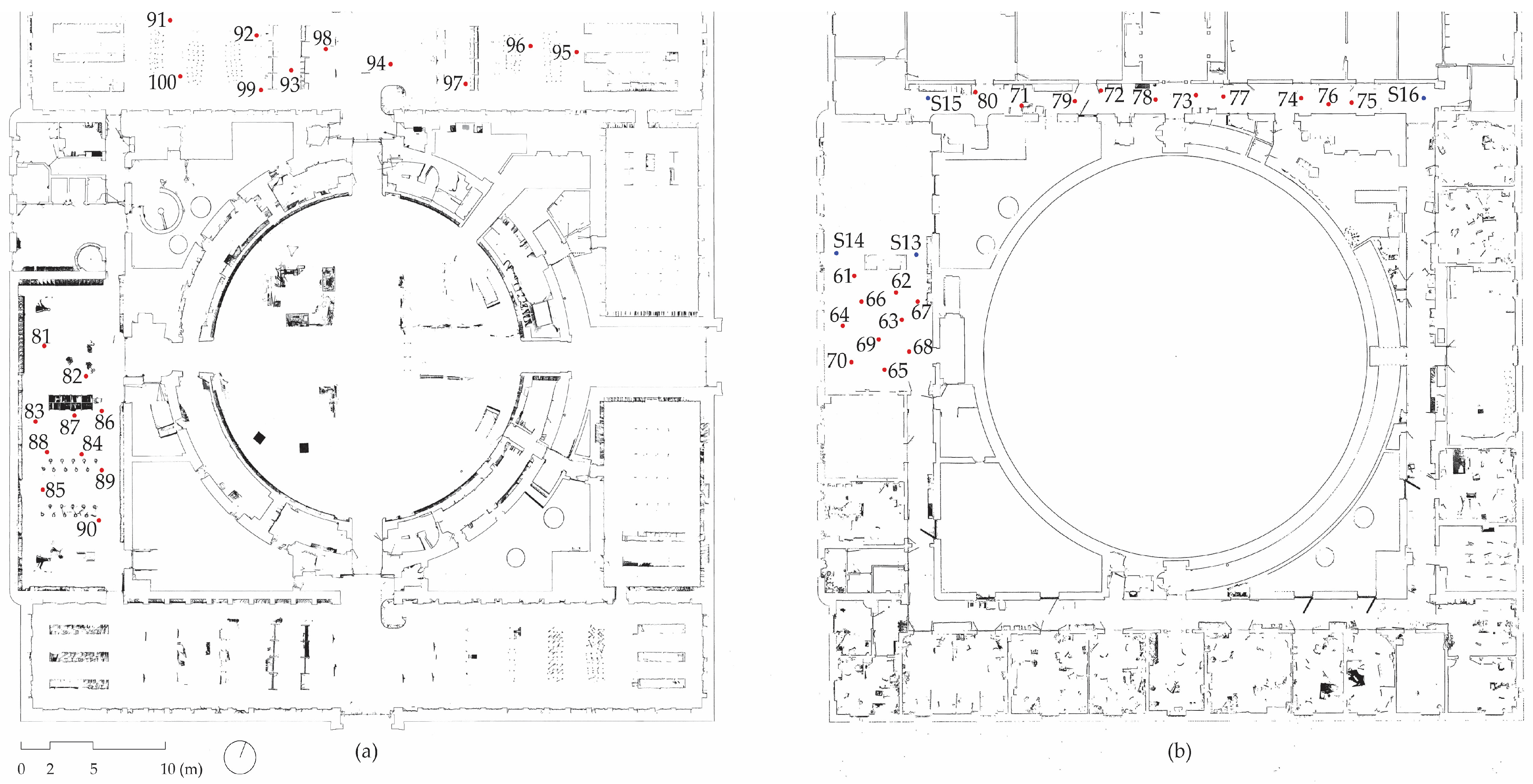
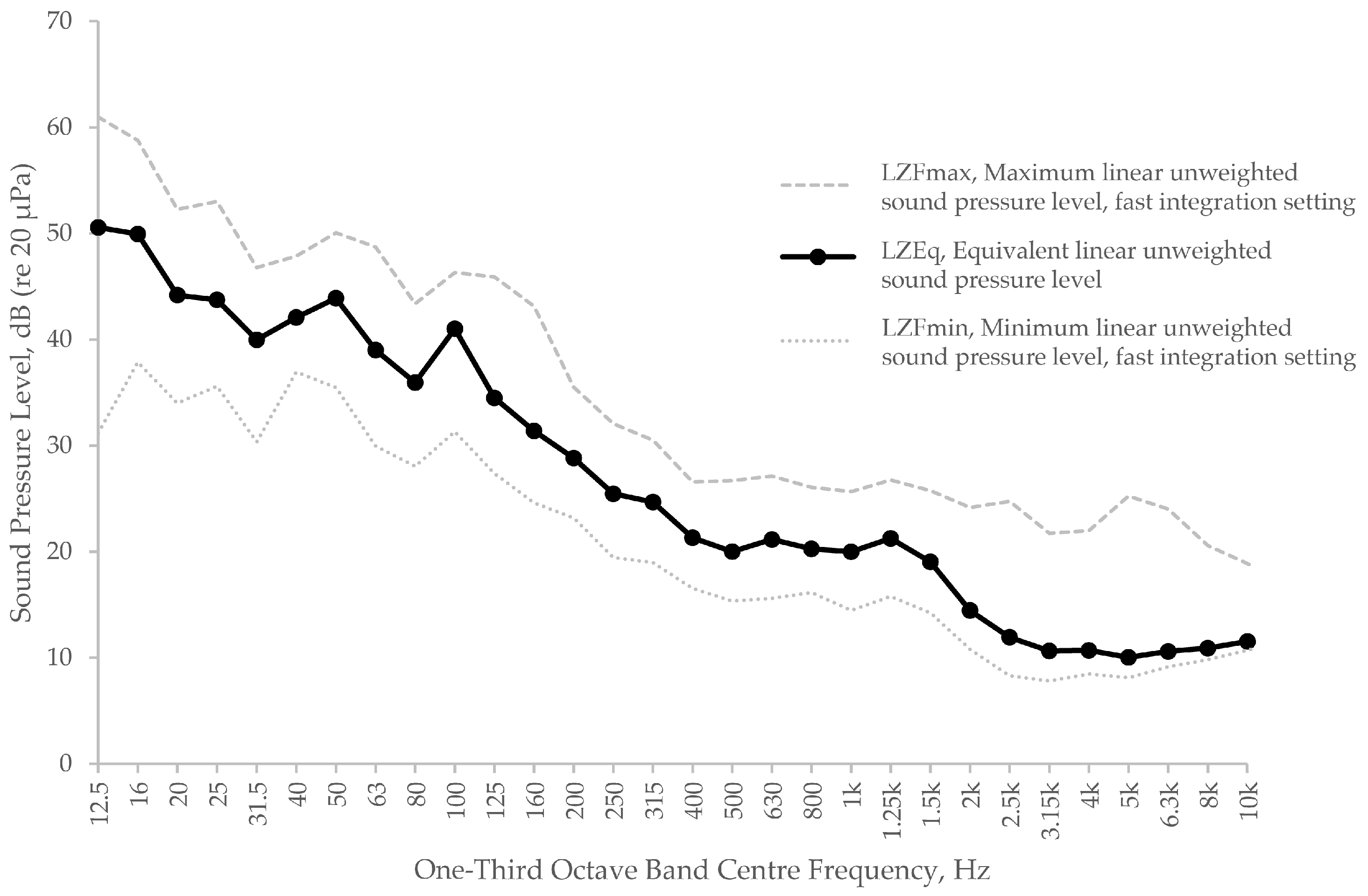

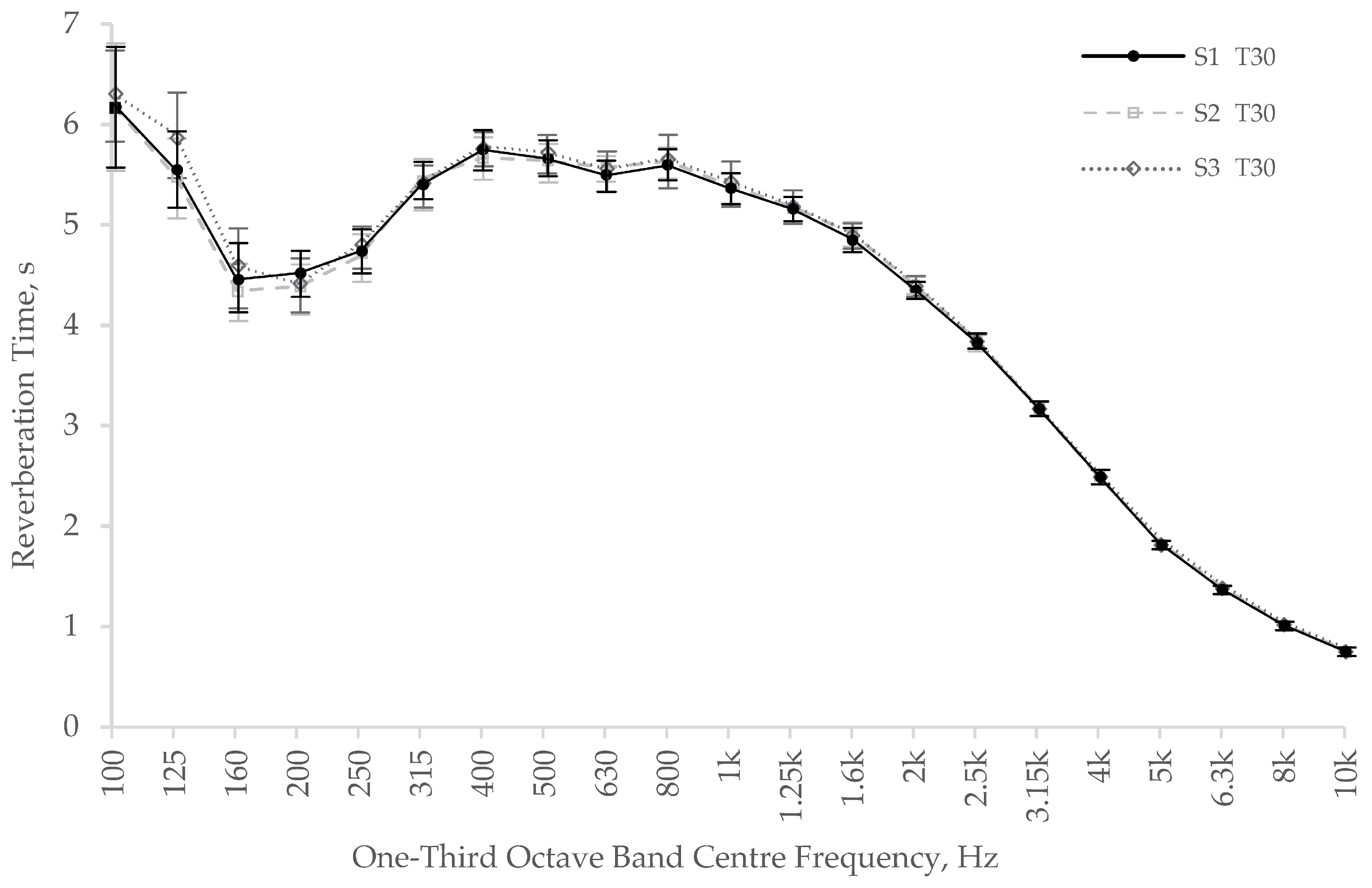
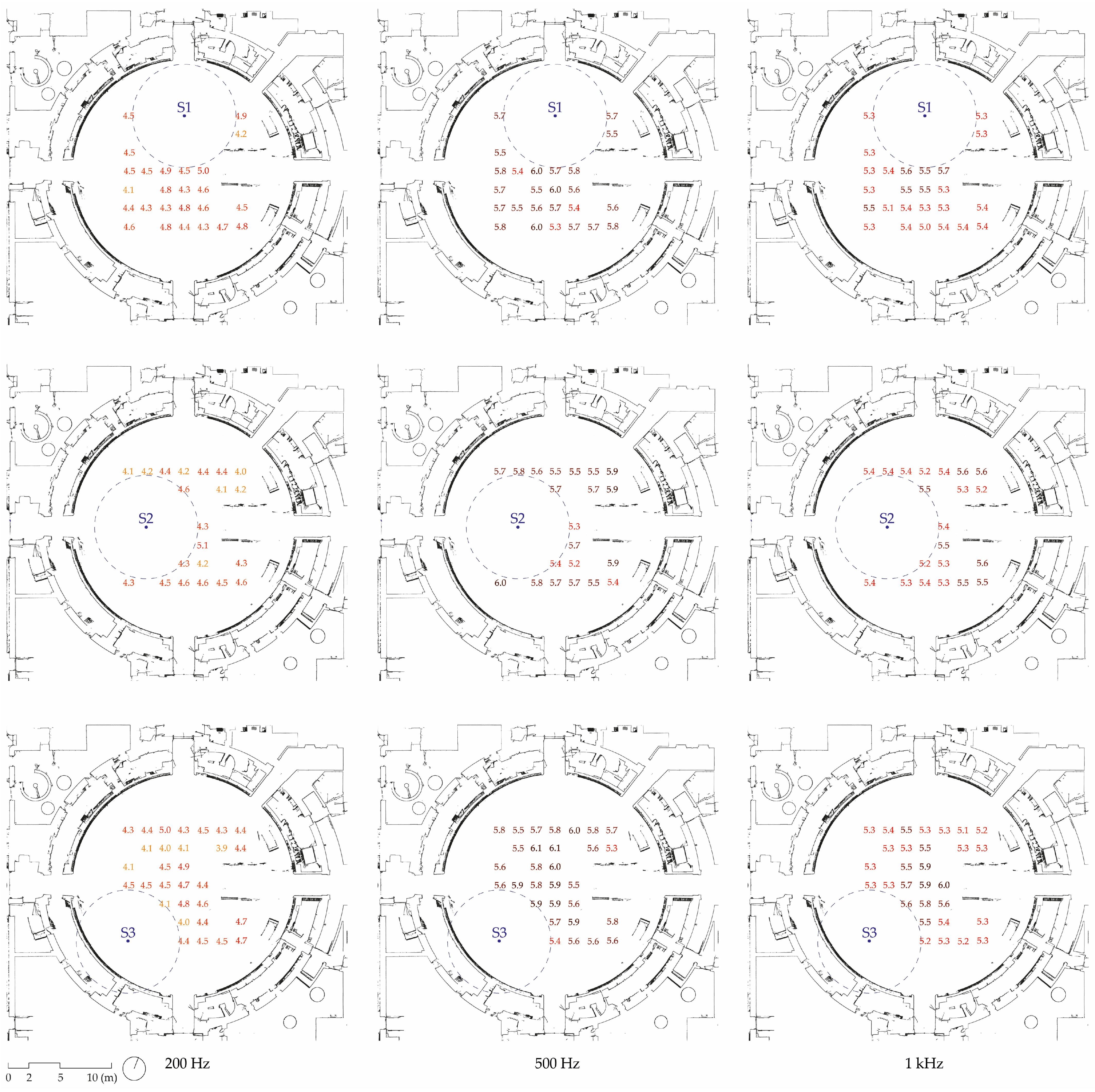


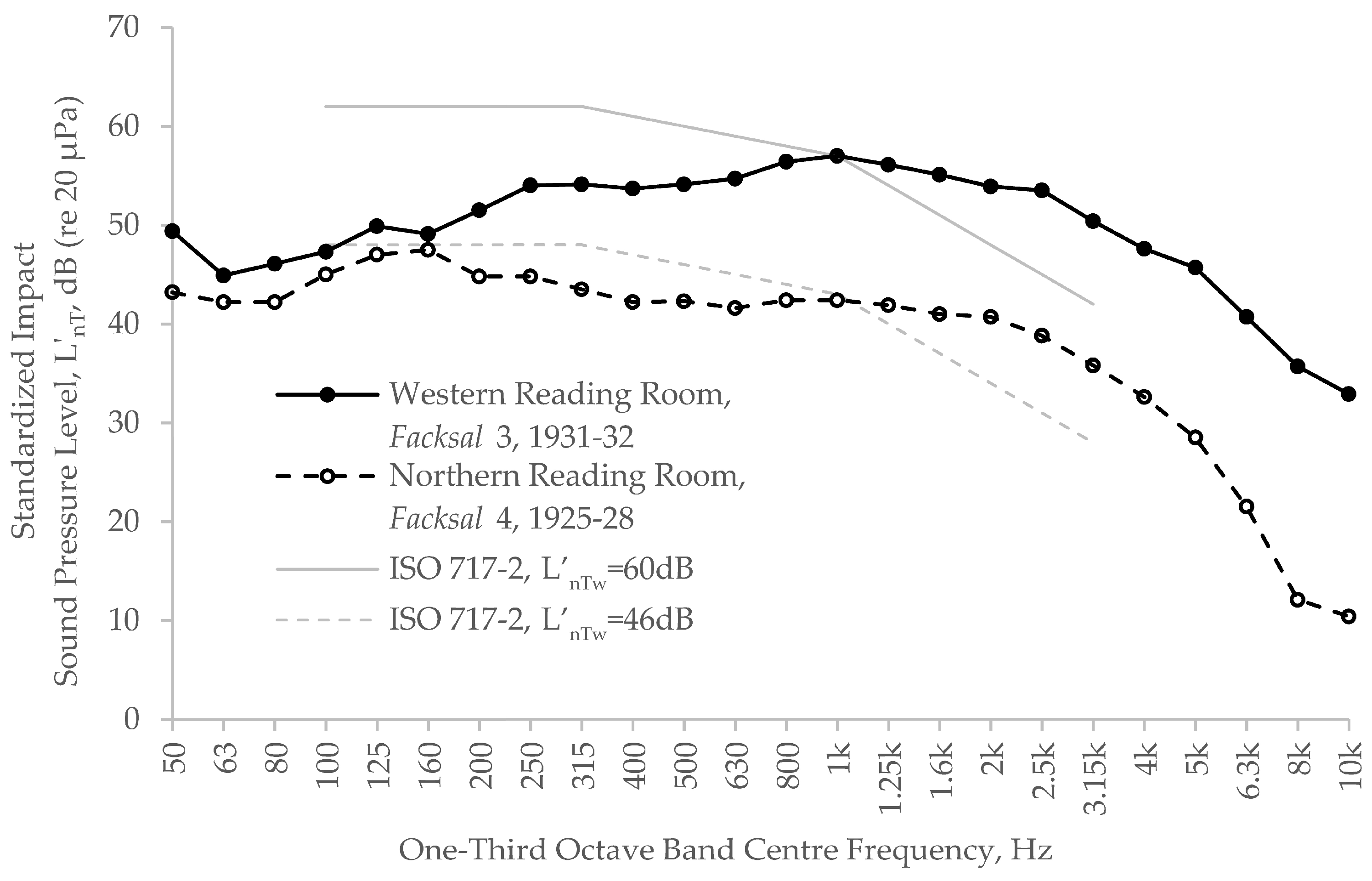
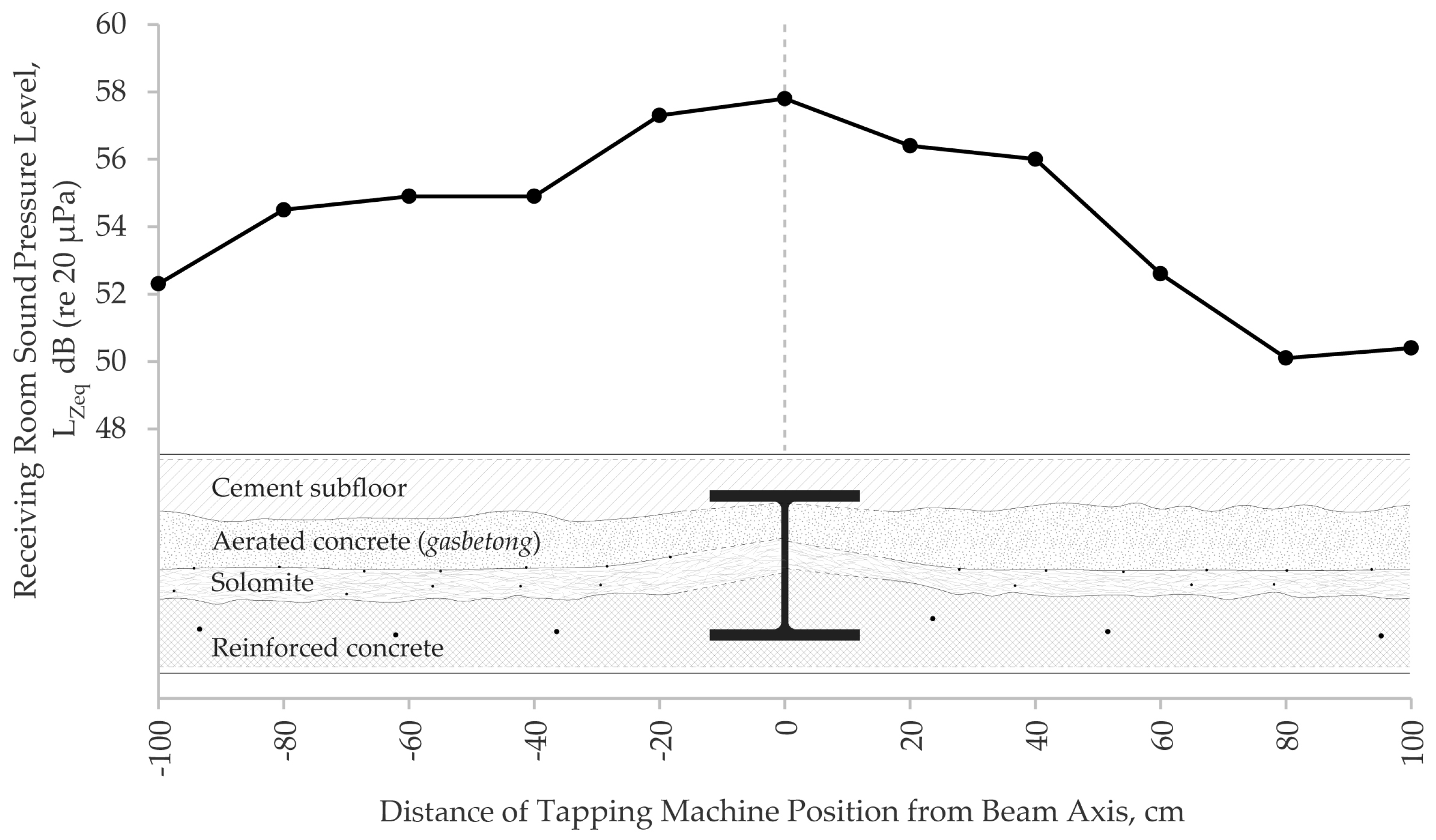
| Room | Date of Construction | Volume (m3) | Architectural Features |
|---|---|---|---|
| Central Rotunda | 1925–28 | 12,000 | Three levels of stepped-back bookshelves Textured, relief-like walls, clerestory windows |
| Reading Room 1 | 1925–28 | 660 | Single level of bookshelves, in front of walls Recessed window openings |
| Reading Room 3 | 1931–32 | 1080 | Two levels of bookshelves, attached to walls Cantilevered gallery of reinforced concrete Rounded transition between ceiling and walls |
| Reading Room 4 | 1925–28 | 2300 | Single level of bookshelves, recessed in walls Recessed window openings |
| Measurement | Source Positions | Receiver Positions for Each Source Position |
|---|---|---|
| Background Noise | - | 16–19, 34–57, and 61–100 |
| Reverberation Time | S1 | 1–19, 22, 27, 28, and 33 |
| S2 | 1–5, 9–12, 19, and 25–33 | |
| S3 | 1–4, 9–14, and 16–33 | |
| S4–S6 | 34–41 | |
| S7–S9 | 42–49 | |
| S10–S12 | 50–57 | |
| Airborne Insulation | S13 | 61–65 and 81–85 |
| S14 | 66–70 and 86–90 | |
| S15 | 71–75 and 91–95 | |
| S16 | 76–80 and 96–100 | |
| Impact Insulation | T1–T8 | 42–49 |
| T9–T16 | 50–57 |
| Room | DnT,w | C | Ctr | C50–3150 | DnT,50 |
|---|---|---|---|---|---|
| Northern Reading Room 4 | 64 | −2 | −6 | −2 | 62 |
| Western Reading Room 3 | 61 | −1 | −4 | −1 | 60 |
| Room | L’nT,w | CI | CI,50–2500 | L’nT,50 |
|---|---|---|---|---|
| Northern Reading Room 4 | 46 | −6 | −5 | 41 |
| Western Reading Room 3 | 60 | −9 | −9 | 51 |
Disclaimer/Publisher’s Note: The statements, opinions and data contained in all publications are solely those of the individual author(s) and contributor(s) and not of MDPI and/or the editor(s). MDPI and/or the editor(s) disclaim responsibility for any injury to people or property resulting from any ideas, methods, instructions or products referred to in the content. |
© 2024 by the author. Licensee MDPI, Basel, Switzerland. This article is an open access article distributed under the terms and conditions of the Creative Commons Attribution (CC BY) license (https://creativecommons.org/licenses/by/4.0/).
Share and Cite
Fleming, P.H. The Historical Building and Room Acoustics of the Stockholm Public Library (1925–28, 1931–32). Acoustics 2024, 6, 754-771. https://doi.org/10.3390/acoustics6030041
Fleming PH. The Historical Building and Room Acoustics of the Stockholm Public Library (1925–28, 1931–32). Acoustics. 2024; 6(3):754-771. https://doi.org/10.3390/acoustics6030041
Chicago/Turabian StyleFleming, Patrick H. 2024. "The Historical Building and Room Acoustics of the Stockholm Public Library (1925–28, 1931–32)" Acoustics 6, no. 3: 754-771. https://doi.org/10.3390/acoustics6030041
APA StyleFleming, P. H. (2024). The Historical Building and Room Acoustics of the Stockholm Public Library (1925–28, 1931–32). Acoustics, 6(3), 754-771. https://doi.org/10.3390/acoustics6030041







